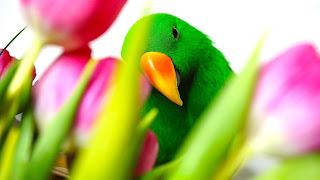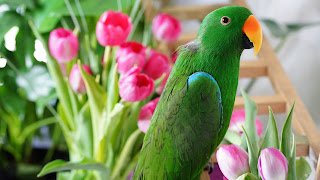Behaviour
Pet birds have been described by some as moody: playful and loving one minute, demanding and aloof the next. Sometimes very obvious and sometimes very subtle, a bird's body language can give you insight into what your bird needs and wants. Although parrots and other birds communicate through different body languages, the following behaviours are observed in most pet birds, some more often than others and some more prominently than others. Observing your bird's eyes, vocalizations, wings, tail, beak, and overall posture can be very telling.
- Singing, talking, and whistling: These vocalizations are often signs of a happy, healthy, content bird. Some birds love an audience and sing, talk, and whistle the most when others are around. Other birds will remain quiet when others are watching.
- Chattering: Chattering can be very soft or very loud. Soft chatter can be a sign of contentment or can be the practice of a bird learning to talk. Loud chatter can be an attention-getter, reminding you that she is there. In the wild, birds often chatter in the evening before going to sleep to connect with other flock members.
- Purring: Not the same as a cat's purr, a bird's purr is more like a soft growl that can be a sign of contentment or a sign of annoyance. When purring, the bird's environment and other body language should be taken into consideration to determine what the bird is expressing.
- Tongue-clicking: By clicking her tongue against her beak, your bird may be entertaining herself or asking to be petted or picked up.
- Growling: Not heard in all pet birds, growling is an aggressive vocalization. If your bird is growling, examine her environment and remove anything that may be bothering her. Growling birds should not be handled as they do not want to be touched.
Wings
- Wing flapping: Wing flapping, or flying in place, is used as exercise, to get your attention, or just display happiness. Birds may often simply lift their wings as a means to stretch or to cool themselves.
- Wing flipping: Wing flipping can mean many different things such as being angry or in pain. Flipping can also be used to fluff the feathers or get the feathers to lay just right. Wing flipping accompanied by hunching of the shoulders and head bobbing is attention-getting and often means that a bird wants to be fed. Flipping may also be a mating behaviour. In this case, giving attention will stimulate egg laying and should be avoided.
- Wing drooping: Young birds must learn how to fold and tuck in their wings and often let their wings droop before learning this. However, in older birds, wing drooping may indicate illness. If the bird has just physically exerted herself or has recently bathed, she may let her wings droop from tiredness or to let the feathers dry.
Feathers
- Ruffled feathers: Birds will ruffle or fluff their feathers during the preening process. This helps remove any dirt or feather dust, and also helps to return the feathers to their normal position. Birds may also be observed fluffing their feathers as a way to relieve tension. If cold, a bird may also fluff her feathers. Finally, if a bird's feathers remain fluffed, it could be a sign of illness and she should be checked by your veterinarian.
- Crest position: Birds such as cockatoos and cockatiels have a large, expressive crest. A contented, relaxed bird will usually have the crest held back, with just the tip tilted up. If she is excited about seeing you, a new toy, food item, etc., she will often lift her crest. If, however, the crest is held very high, it indicates fear or great excitement, and should be taken as a warning. An aggressive or alarmed bird may hold the crest flat while crouching and hissing.
- Quivering: Quivering may occur when the bird is frightened, overly excited, or part of breeding behavior.
- Tail wagging: A bird, like a dog, may wag her tail to tell you that she is glad to see you. Tail wagging can also be a precursor to defecating. This is often helpful if you are trying to house train your bird. For more information on house training your bird, see the article House training.
- Tail flipping: Tail flipping is a general sign of happiness and can be seen when she is happy to see you, plays with her favourite toy, or gets a treat.
- Tail bobbing: Tail bobbing accompanied by rapid breathing that follows strenuous exercise is your bird's way of catching her breath. If, however, your bird is bobbing her tail feathers and breathing hard without activity, she may be showing signs of respiratory distress or infection. If this occurs, see your veterinarian.
- Tail fanning: Fanning the tail feathers often accompanies other behaviours in a show of aggression or anger. Spreading out the tail feathers is a show that displays the bird's strength and vitality.
- Foot tapping: Some birds, especially cockatoos, will tap their feet as a sign of dominance over their territory. This usually only happens when they feel their territory is threatened.
- Weak legs: Some birds that do not want to stand or perch for themselves display the sudden onset of "weak legs." This most often occurs when you have been handling them and must put them back in their cage; it is their way of resisting. Simply hold and pet the bird a while longer and, when she feels she has been given adequate attention, her legs will suddenly become strong enough to perch. Some birds become very good at this behaviour and make it routine.
- Hanging upside down: Some birds consider hanging upside down a natural part of their behaviour. When doing this, they are happy and content with their environment.
- Scratching on the cage bottom: Birds from those species who normally forage on the ground for food, like the African Grey, may scratch on the floor of the cage, much like a chicken.
- Grinding: Beak grinding is often a sign of contentment in birds and is heard most often as the bird falls asleep. It is characterized by the side-to-side sliding of one beak over the other. It is believed by some experts that birds grind their beaks to keep them in their best condition.
- Clicking: Clicking of the beak, or the back and forth sliding of one beak tip over the other, can mean several things. If she clicks once and pins her eyes but is otherwise unthreatening, she is greeting you or acknowledging something. If she clicks several times in a series, she is giving a warning and should not be handled. Beak clicking is seen most often in cockatiels and cockatoos.
- Wiping: It is common to see a bird wiping her beak after eating. Often, the bird will wipe her beak on a perch, the cage floor, or the cage sides to get it clean. Some birds use beak wiping as a way to mark their territory. This behaviour may be seen in birds when introduced to others or kept in areas in which other birds are near.
- Biting: Birds will bite for several reasons so it is important to observe other behaviours and the bird's immediate environment to determine the reason behind it. Defending territory, being fearful, or being angry can all cause a bird to bite. An open beak combined with a crouching position and hissing is a definite indication that the bird is prepared to bite.
- Chewing: Most birds enjoy chewing and do it for many reasons including to condition their beaks and to entertain themselves. A variety of chew toys should be provided to keep your bird stimulated and interested and to keep her from chewing, and possibly ingesting, inappropriate things.
- Regurgitating: Regurgitation is the expulsion of contents from the mouth, esophagus, or crop. If your bird pins her eyes, bobs her head and stretches out her neck, then regurgitates her dinner, she is showing you a great deal of affection. Birds feed their young by regurgitating food and breeding pairs often do this for each other as a part of bonding.
- Mouthing: One way birds play is to grab each other's beaks and wrestle. They will often use their beaks to joust at one another during play.
- Head shaking: It is very common for African Greys to shake their heads. The reason for this is not well understood.
- Head bobbing: Birds, who want attention, may bob their heads back and forth.
- Relaxed: If the bird has a relaxed body and her head and body are at attention, she is happy and content.
- At Attention: If her head and body are at attention but her body is rigid and her feathers are flared, she is letting you know she owns that territory.
- Bowing: When a bird is crouching with her head tipped downward toward you, and perhaps bobbing her head, she is asking to be petted or scratched.
- Head down: If she is crouching with her head down with a relaxed body and raised wings, she is trying to attract attention, either from you or from a potential mate.
- Aggressive: If a bird is crouching with her head down, eyes pinning, flared tail feathers, ruffled feathers, and a rigid body, weaving from side to side, she is giving a warning and won't hesitate to bite if provoked, even in the most minor way. If this stance is accompanied by an urgent walk toward you, it is best to get out of the way until she has time to cool off. Hissing and a raised crest may be additional clues that the bird is in an aggressive state.
- Lying on back: Though probably uncommon in the wild, some pet birds will lie on their backs, and may even sleep in that position.
- Elimination posture: Prior to defecating, a bird may take several steps backward, crouch, and lift her tail.
By Angela Kemp
__________
Monika Sangar, MSc – Molecular Biology | Avian Nutrition Specialist | Founder: PDSnonprofit | Owner: Pds Parrot Shop
Monika Sangar holds a Master of Science in Molecular Biology and is a dedicated Avian Nutrition Specialist with over 14 years of hands-on experience rescuing and rehabilitating parrots. As the founder of PDSnonprofit and Owner of PDS Parrot Shop, she combines scientific knowledge with practical expertise to create enrichment-focused bird toys and species-appropriate diets. Her work emphasizes evidence-based care, behavioral enrichment, and long-term wellness for companion parrots. She is also an author who wrote, The Science of Avian Nutrition: https://a.co/d/f14lNl3
PDS is a registered 501(c)(3) nonprofit organization (tax id #46-2470926)









